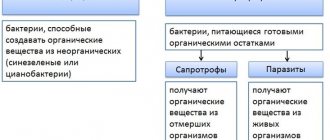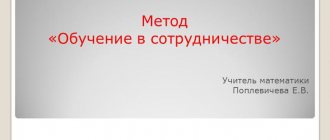Use of ICT technologies by preschool teachers
The use of ICT technologies in the educational process in the context of the introduction of the Federal State Educational Standard of the Preschool Educational Institution
Author: Buzmakova Svetlana Vladimirovna, teacher of the Municipal Preschool Educational Institution “Kindergarten No. 88”, Berezniki, Perm Territory Description: the work will be of interest to teachers who use ICT technologies when organizing work in the preschool educational institution, the work contains a description of the experience of implementing ICT technologies; the work identifies the problems and prospects for using ICT technologies in preschool educational institutions. Goal: Creating conditions for increasing the level of ICT competence of teachers of preschool educational institutions for the successful implementation of the Federal State Educational Standards of preschool educational institutions. Social and economic changes in Russia have led to the need to modernize many social institutions, and primarily the education system. New tasks set for education today are formulated and presented in the law “On Education of the Russian Federation” and the educational standard of the new generation. Informatization of education in Russia is one of the most important mechanisms affecting all main directions of modernization of the educational system. Its main task is the effective use of the following most important advantages of information and communication technologies: - The ability to organize the process of cognition that supports an activity-based approach to the educational process; — Individualization of the educational process while maintaining its integrity; — Creation of an effective management system for information and methodological support of education. The key directions of the process of informatization of preschool educational institutions are: 1. Organizational: - Modernization of the methodological service; — Improving the material and technical base; — Creation of a certain information environment. 2. Pedagogical: - Increasing ICT - competence of preschool teachers; — Introduction of ICT into the educational space. In accordance with the Law “On Education in the Russian Federation,” preschool education is one of the levels of general education. Therefore, informatization of kindergarten has become a necessary reality of modern society. Computerization of school education has a fairly long history (about 20 years), but such a widespread use of computers in kindergarten has not yet been observed. At the same time, it is impossible to imagine the work of a teacher (including a preschool teacher) without the use of information resources. The use of ICT makes it possible to enrich, qualitatively update the educational process in preschool educational institutions and increase its efficiency. What is ICT? Information educational technologies are all technologies in the field of education that use special technical means (PC, multimedia) to achieve pedagogical goals.
Information and communication technologies in education (ICT) is a complex of educational and methodological materials, technical and instrumental means of computer technology in the educational process, forms and methods of their use to improve the activities of specialists in educational institutions (administration, educators, specialists), as well as for education (development, diagnosis, correction) of children. Areas of application of ICT by preschool teachers
1.
Maintaining documentation. In the process of educational activities, the teacher draws up and draws up calendar and long-term plans, prepares material for the design of the parent corner, conducts diagnostics and presents the results both in printed and electronic form. Diagnostics should be considered not as a one-time carrying out of the necessary research, but also as maintaining an individual diary of the child, in which various data about the child, test results are recorded, charts are drawn up, and the dynamics of the child’s development are generally monitored. Of course, this can be done without the use of computer technology, but the quality of design and time costs are not comparable. An important aspect of the use of ICT is the preparation of teachers for certification. Here you can consider both the preparation of documentation and the preparation of an electronic portfolio. 2. Methodological work, teacher training . In the information society, networked electronic resources are the most convenient, fastest and most modern way to disseminate new methodological ideas and teaching aids, available to methodologists and teachers regardless of their place of residence. Information and methodological support in the form of electronic resources can be used when preparing a teacher for classes, to study new techniques, and when selecting visual aids for classes. Online communities of teachers allow not only to find and use the necessary methodological developments, but also to post their materials, share their teaching experience in preparing and conducting events, and using various methods and technologies. The modern educational environment requires special flexibility from the teacher when preparing and conducting pedagogical events. A teacher needs to regularly improve his qualifications. The ability to implement modern teacher requests is also possible using remote technologies. When choosing such courses, you need to pay attention to the availability of a license on the basis of which educational activities are carried out. Distance training courses allow you to choose the direction of interest to the teacher and study without interrupting your main educational activities. An important aspect of a teacher’s work is participation in various pedagogical projects, distance competitions, quizzes, and Olympiads, which increases the level of self-esteem of both the teacher and students. In-person participation in such events is often impossible due to the remoteness of the region, financial costs and other reasons. And remote participation is available to everyone. In this case, it is necessary to pay attention to the reliability of the resource and the number of registered users. It is undeniably important to use ICT technologies both for maintaining documentation and for more effectively conducting methodological work and for improving the level of qualifications of a teacher, but the main thing in the work of a preschool teacher is the conduct of the educational process. 3. Educational process. The educational process includes: - organization of direct educational activities of the pupil, - organization of joint developmental activities of the teacher and children, - implementation of projects, - creation of a developmental environment (games, manuals, teaching materials).
In preschool children, visual-figurative thinking predominates. The main principle when organizing the activities of children of this age is the principle of clarity. The use of a variety of illustrative material, both static and dynamic, allows preschool teachers to quickly achieve their intended goal during direct educational activities and joint activities with children. The use of Internet resources makes it possible to make the educational process information-intensive, entertaining and comfortable. Types of activities with ICT
1.
Lesson with multimedia support. In such a lesson, only one computer is used as an “electronic board”. At the preparation stage, electronic and information resources are analyzed and the necessary material for the lesson is selected. Sometimes it can be very difficult to find the necessary materials to explain the topic of a lesson, so presentation materials are created using PowerPoint or other multimedia programs. To conduct such classes, you need one personal computer (laptop), a multimedia projector, speakers, and a screen. The use of multimedia presentations allows you to make the lesson emotionally charged, interesting, they are an excellent visual aid and demonstration material, which contributes to the good results of the lesson. With the help of multimedia presentations, children learn complexes of visual gymnastics and exercises to relieve visual fatigue. Multimedia presentations make it possible to present educational and developmental material as a system of vivid supporting images filled with comprehensive structured information in an algorithmic order. In this case, various channels of perception are involved, which makes it possible to embed information not only in factual, but also associative form in the memory of children. The purpose of this presentation of developmental and educational information is to form a system of mental images in children. Presenting material in the form of a multimedia presentation reduces learning time and frees up children's health resources. The use of multimedia presentations in the classroom makes it possible to build the educational process on the basis of psychologically correct modes of functioning of attention, memory, mental activity, humanization of the content of learning and pedagogical interactions, reconstruction of the learning and development process from the standpoint of integrity. The basis of any modern presentation is to facilitate the process of visual perception and memorization of information with the help of vivid images. The forms and place of use of a presentation in a lesson depend on the content of this lesson and the goal set by the teacher. The use of computer slide presentations in the process of teaching children has the following advantages: - Implementation of multisensory perception of the material; — Possibility of demonstrating various objects using a multimedia projector and projection screen in a many times enlarged form; — Combining audio, video and animation effects into a single presentation helps compensate for the amount of information children receive from educational literature; — The ability to demonstrate objects that are more accessible to the intact sensory system; — Activation of visual functions, eye abilities of the child; — Computer presentation slide films are convenient to use for displaying information in the form of printouts in large font on a printer as handouts for classes with preschoolers. The use of multimedia presentations allows you to make classes emotionally charged, attractive, arouse keen interest in the child, and are an excellent visual aid and demonstration material, which contributes to the good results of the lesson. For example, the use of presentations in classes in mathematics, music, familiarization with the outside world ensures the activity of children when examining, examining and visually identifying the signs and properties of objects; methods of visual perception, examination, and identifying qualitative, quantitative and spatio-temporal features in the objective world are formed. and properties, visual attention and visual memory develop. 2. Classes with computer support Most often, such classes are conducted using game-based training programs. In this lesson, several computers are used, on which several students work simultaneously. The use of an electronic textbook (and a gaming educational game for children is an electronic textbook) is a method of programmable learning, the founder of which is Skinner. Working with an electronic textbook, the child independently studies the material, completes the necessary tasks and then passes a competency test on this topic. The computer's capabilities make it possible to increase the volume of material offered for review. A bright glowing screen attracts attention, makes it possible to switch children's audio perception to visual, animated characters arouse interest, and as a result, tension is relieved. But today, unfortunately, there is an insufficient number of good computer programs that are intended for children of this age. Experts identify a number of requirements that developmental programs for children must satisfy: - exploratory in nature, - ease for a child to study independently, - development of a wide range of skills and ideas, - high technical level, - age appropriate, - entertaining. Types of educational programs for preschool children 1. Games for the development of memory, imagination, thinking, etc. 2. “Talking” dictionaries of foreign languages with good animation. 3. ART studios, simple graphic editors with libraries of drawings. 4. Travel games, “action games”. 5. The simplest programs for teaching reading, mathematics, etc. The use of such programs allows not only to enrich knowledge, to use a computer for a more complete acquaintance with objects and phenomena that are beyond the child’s own experience, but also to increase the child’s creativity; the ability to operate with symbols on a monitor screen helps optimize the transition from visual-figurative to abstract thinking; the use of creative and director's games creates additional motivation in the formation of educational activities; Individual work with a computer increases the number of situations that a child can solve independently. When organizing classes of this type, it is necessary to have a stationary or mobile computer class that complies with SANPiN standards and licensed software. Today, many kindergartens are equipped with computer classes. But the following are still missing: - Methodology for using ICT in the educational process of preschool educational institutions; — Systematization of computer development programs; — Unified software and methodological requirements for computer classes. Today, this is the only type of activity that is not regulated by a special educational program. Teachers have to independently study the approach and implement it in their activities. The use of ICT does not provide for teaching children the basics of computer science and computer technology. An important rule when organizing such classes is their frequency. Classes should be held 1-2 times a week, depending on the age of the children, for 10-15 minutes of direct activity at the PC. 3. Diagnostic lesson. To conduct such classes, special programs are required, which is rare or does not exist in some general education programs. But the development of such computer programs is a matter of time. Using application software, you can develop test tasks and use them for diagnostics. In the process of conducting traditional diagnostic classes, the teacher needs to record the level of problem solving by each child according to certain indicators. The use of special computer programs will not only make the teacher’s work easier and reduce time costs (use several computers at the same time), but will also allow you to save diagnostic results, considering them over time. Thus, in contrast to conventional technical means of education, information and communication technologies make it possible not only to saturate the child with a large amount of ready-made, strictly selected, appropriately organized knowledge, but also to develop intellectual, creative abilities, and what is very important in early childhood - the ability to independently acquire new knowledge. The use of computers in educational and extracurricular activities looks very natural from the child’s point of view and is one of the effective ways to increase motivation and individualize learning, develop creative abilities and create a favorable emotional background. Modern research in the field of preschool pedagogy K.N. Motorina, S.P. Pervina, M.A. Kholodnoy, S.A. Shapkina et al. indicate the possibility of mastering a computer by children aged 3-6 years. As is known, this period coincides with the moment of intensive development of the child’s thinking, preparing the transition from visual-figurative to abstract-logical thinking. The introduction of information technologies has advantages over traditional means of teaching: 1. ICT makes it possible to expand the use of electronic learning tools, as they transmit information faster; 2. Movements, sound, animation attract children's attention for a long time and help increase their interest in the material being studied. The high dynamics of the lesson contributes to the effective assimilation of the material, the development of memory, imagination, and creativity of children; 3. Provides clarity, which promotes perception and better memorization of material, which is very important, given the visual-figurative thinking of preschool children. In this case, three types of memory are included: visual, auditory, motor; 4. Slideshows and video clips allow you to show those moments from the surrounding world that are difficult to observe: for example, the growth of a flower, the rotation of planets around the Sun, the movement of waves, it’s raining; 5. You can also simulate such life situations that are impossible or difficult to show and see in everyday life (for example, reproducing the sounds of nature; the operation of transport, etc.); 6. The use of information technology encourages children to search for research activities, including searching the Internet independently or together with their parents; 7. ICT is an additional opportunity to work with children with disabilities. With all the constant advantages of using ICT in preschool education, the following problems
: 1.
Material base of the preschool educational institution. As noted above, to organize classes you must have a minimum set of equipment: a PC, a projector, speakers, a screen or a mobile classroom. Not all kindergartens today can afford to create such classes. 2. Protecting the child's health. Recognizing that the computer is a new powerful tool for the development of children, it is necessary to remember the commandment “DO NO HARM!” The use of ICT in preschool institutions requires careful organization of both the classes themselves and the entire regime as a whole in accordance with the age of the children and the requirements of the Sanitary Rules. When computers and interactive equipment operate indoors, specific conditions are created: humidity decreases, air temperature rises, the number of heavy ions increases, and electrostatic voltage in the area of children's hands increases. The intensity of the electrostatic field increases when finishing the cabinet with polymer materials. The floor must have an antistatic coating, and the use of carpets and rugs is not permitted. To maintain an optimal microclimate, prevent the accumulation of static electricity and deterioration of the chemical and ionic composition of the air, it is necessary to: ventilate the office before and after classes, wet cleaning before and after classes. We conduct classes with older preschoolers once a week in subgroups. In his work, a teacher must necessarily use a set of eye exercises. 3. Insufficient ICT – teacher competence. The teacher must not only perfectly know the content of all computer programs, their operational characteristics, the user interface of each program (the specific technical rules for operating with each of them), but also understand the technical characteristics of the equipment, be able to work in basic application programs, multimedia programs and the network Internet.
If the preschool educational institution team manages to solve these problems, then ICT technologies will become a great help. The use of information technology will help the teacher increase the motivation of children's learning and will lead to a number of positive consequences: - enriching children with knowledge in their figurative-conceptual integrity and emotional coloring; - facilitating the process of learning material by preschoolers; - arousing keen interest in the subject of knowledge; — expanding the general horizons of children; - increasing the level of use of visual aids in the classroom; — increasing teacher productivity. It is undeniable that in modern education the computer does not solve all problems; it remains just a multifunctional technical teaching tool. No less important are modern pedagogical technologies and innovations in the learning process, which make it possible not only to “invest” in each child a certain stock of knowledge, but, first of all, to create conditions for the manifestation of his cognitive activity. Information technologies, in combination with properly selected (or designed) teaching technologies, create the necessary level of quality, variability, differentiation and individualization of training and education. So, the use of information technology will make the process of learning and development of children quite simple and effective, free them from routine manual work, and open up new opportunities for early education. Informatization of education opens up new opportunities for teachers to widely introduce new methodological developments into teaching practice aimed at intensifying and implementing innovative ideas in educational, educational and correctional processes. Recently, information and communication technologies (ICT) have become a good assistant for teachers in organizing educational and correctional work. Unlike conventional technical means of education, information and communication technologies make it possible not only to saturate the child with a large amount of ready-made, strictly selected, appropriately organized knowledge, but also to develop intellectual, creative abilities, and what is very important in preschool childhood - the ability to independently acquire new knowledge. The use of information technologies in education makes it possible to significantly enrich, qualitatively update the educational process in preschool educational institutions and increase its efficiency. List of used literature.
1. Management of innovation processes in preschool educational institutions. – M., Sfera, 2008 2. Gorvits Yu., Pozdnyak L. Who should work with a computer in kindergarten. Preschool education, 1991, No. 5 3. Kalinina T.V. DOW management. "New information technologies in preschool childhood." M, Sfera, 2008 4. Ksenzova G.Yu. Promising school technologies: educational and methodological manual. - M.: Pedagogical Society of Russia, 2000 5. Motorin V. “Educational capabilities of computer games.” Preschool education, 2000, No. 11 6. Novoselova S.L. Computer world of a preschooler. M.: New School, 1997
We recommend watching:
The role of ICT in the educational process Lesson constructor - a method of object-oriented design of lessons How to effectively carry out interaction between a family and a preschool educational institution Generalization of the experience of a speech therapist teacher. Use of ICT
Similar articles:
Information technology in English lessons
Effective ways to use ICT in the educational process
ICT helps to stimulate children's interest in learning new materials. There is now a very large variety of educational materials available on the Internet. In fact, preschool educational institutions may not even create educational materials, but use existing ones. As a rule, such services comply with the requirements of the Federal State Educational Standard, and are created jointly with the Ministry of Education or even by order of it.
Educators can only monitor the correct use of IT technologies, as well as teach children to use computers and Internet resources.
The use of information and communication technologies in education has tangible advantages:
- It can give children an incentive to explore the Internet, because it contains a huge amount of useful information. The main thing is to teach children to find useful information, and various educational programs should be aimed at this.
- It will help motivate children to self-learn, because this pedagogical method is much more effective than conventional teaching, which, in a word, is already beginning to become obsolete, and society is very quickly improving it due to various scientific achievements. Stimulating such self-study can help to take the initial level of study at a university, and further admission to it may be easier.
- Develops communication skills.
- Experience in using information technologies proves that they help in certifying children.
How to teach a 4-5 year old child to draw
Important! Professions related to information technology are currently developing, labor automation is taking place in most industries, and employers are in great need of people who are ready to use computer technology as a means to solve assigned problems.
Due to automation, a large number of frames are required for data processing. Therefore, it is important, starting from preschool educational institutions, to introduce the younger generation to computer technologies.
Creation of a modern educational environment in preschool educational institutions
Due to technological progress, various IT technologies are becoming cheaper every year, so equipping a preschool educational institution does not cost much. IT equipment will help children learn faster. In addition, information technologies can help the institution itself in organizing various events, and in organizing the course work of the institution itself as a whole.
Interactive technologies in preschool educational institutions
You can create an educational environment using various educational programs. There are a large number of government concepts aimed at connecting educational institutions to the Internet.
interactive board



